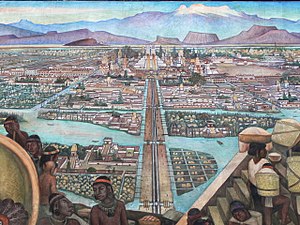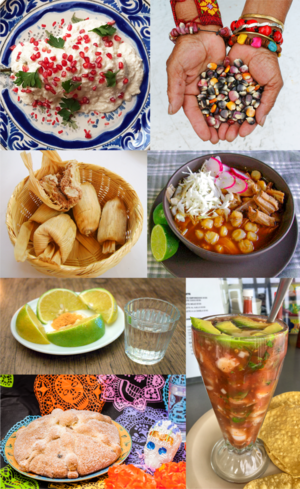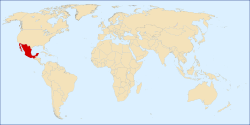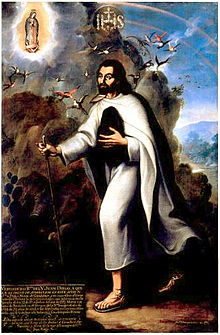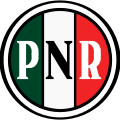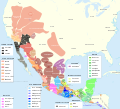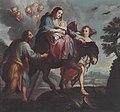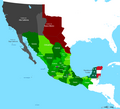¡Bienvenido! Welcome to the Mexico portal
Mexico , officially the United Mexican States , is a country in the southern portion of
North America . Covering 1,972,550 km2 (761,610 sq mi), it is the world's
13th largest country by area; with a population of almost 130 million, it is the
10th most populous country and has the most
Spanish speakers in the world. Mexico is organized as a
federal
constitutional republic comprising 31
states and
Mexico City , its capital and
largest city , which is among the
world's most populous metropolitan areas . The country shares land
borders
with the United States to the north,
with Guatemala
and Belize to the southeast; as well as maritime borders with the
Pacific Ocean to the west, the
Caribbean Sea to the southeast, and the
Gulf of Mexico to the east.
Pre-Columbian Mexico dates back to 8,000
BC , making it one of the world's six
cradles of civilization . The
Mesoamerican region hosted various intertwined civilizations, including the
Olmec ,
Maya ,
Zapotec ,
Teotihuacan , and
Purepecha . The
Aztecs came to dominate the area prior to
European contact . In 1521, the
Spanish Empire , alongside indigenous allies,
conquered the Aztec Empire , establishing the colony of
New Spain centered in the former capital,
Tenochtitlan (now
Mexico City ). Over the next three centuries, Spain expanded its territorial control, enforced
Christianity , and spread the Spanish language, with the colony's rich silver deposits fueling its empire. The colonial era ended in the early 19th century with the
Mexican War of Independence . (
Full article... )
This is a
Featured article , which represents some of the best content on English Wikipedia. The
Mayan languages form a
language family spoken in
Mesoamerica , both in the south of Mexico and northern
Central America . Mayan languages are spoken by at least six million
Maya people , primarily in
Guatemala ,
Mexico ,
Belize ,
El Salvador and
Honduras . In 1996, Guatemala formally recognized 21 Mayan languages by name, and Mexico
recognizes eight within its territory.
The Mayan language family is one of the best-documented and most studied in the
Americas . Modern Mayan languages descend from the
Proto-Mayan language , thought to have been spoken at least 5,000 years ago; it has been partially
reconstructed using the
comparative method . The proto-Mayan language diversified into at least six different branches: the
Huastecan ,
Quichean ,
Yucatecan ,
Qanjobalan ,
Mamean and
Chʼolan–Tzeltalan branches. (
Full article... )
List of Featured articles
Mural by
Diego Rivera showing the pre-Columbian
Aztec city of
Tenochtitlán . In the
Palacio Nacional in
Mexico City .
Mexican muralism refers to the art project initially funded by the Mexican government in the immediate wake of the
Mexican Revolution (1910–1920) to depict visions of Mexico's past, present, and future, transforming the walls of many public buildings into didactic scenes designed to reshape Mexicans' understanding of the nation's history. The
murals , large artworks painted onto the walls themselves had social, political, and historical messages. Beginning in the 1920s, the muralist project was headed by a group of artists known as "The Big Three" or "The Three Greats". This group was composed of
Diego Rivera ,
José Clemente Orozco and
David Alfaro Siqueiros . Although not as prominent as the Big Three, women also created murals in Mexico. From the 1920s to the 1970s, murals with nationalistic, social and political messages were created in many public settings such as chapels, schools, government buildings, and much more. The popularity of the Mexican muralist project started a tradition which continues to this day in
Mexico ; a tradition that has had a significant impact in other parts of the Americas, including the
United States , where it served as inspiration for the
Chicano art movement . (
Full article... )
List of selected articles
Bodegón con frutas (con alacrán y rana) (English:
Still life with fruit (with scorpion and frog) ) (1874),
Hermenegildo Bustos ,
Museo Nacional de Arte
This is a
Good article , an article that meets a core set of high editorial standards.
Antonio Ezequiel Cárdenas Guillén (5 March 1962 – 5 November 2010), commonly referred to by his alias Tony Tormenta ("Tony Storm"), was a Mexican
drug lord and co-leader of the
Gulf Cartel , a drug trafficking organization based in
Tamaulipas . He headed the criminal group along with
Jorge Eduardo Costilla Sánchez . Antonio was considered by Mexican security forces as one of
Mexico's most-wanted men .
Born in
Matamoros, Tamaulipas , Antonio initially worked as a car washer at a local police station with his brother
Osiel Cárdenas Guillén , former leader of the cartel. By the late 1980s, he entered the drug trade, and later became the crime boss of Matamoros, where he controlled the city's drug trafficking shipments and all organized crime activities. Few details were known of Antonio's criminal career prior to 1999, when his brother Osiel
confronted federal agents at gunpoint with several of his gunmen in Matamoros. In 1998, Antonio avoided arrest after
FBI and
DEA agents tracked his whereabouts inside a domicile in Houston. Back in Mexico, his brother Osiel was the Gulf Cartel's main leader and had created a paramilitary squad known as
Los Zetas , formed by soldiers who left the Mexican military. (
Full article... )
Saint Juan Diego by
Miguel , 1752
Juan Diego Cuauhtlatoatzin , also known simply as
Juan Diego (Spanish pronunciation:
[ˌxwanˈdjeɣo] ; 1474–1548), was a
Chichimec
peasant and
Marian visionary . He is said to have been granted apparitions of
Our Lady of Guadalupe on four occasions in December 1531: three at the hill of
Tepeyac and a fourth before
don Juan de Zumárraga , then
bishop of Mexico . The
Basilica of Our Lady of Guadalupe , located at the foot of Tepeyac, houses the cloak (
tilmahtli ) that is traditionally said to be Juan Diego's, and upon which the image of the Virgin is said to have been miraculously impressed as proof of the authenticity of the apparitions.
Juan Diego's visions and the imparting of the miraculous image, as recounted in oral and written colonial sources such as the
Huei tlamahuiçoltica , are together known as the Guadalupe event (
Spanish :
el acontecimiento Guadalupano ), and are the basis of the veneration of
Our Lady of Guadalupe . This veneration is ubiquitous in Mexico, prevalent throughout the Spanish-speaking Americas, and increasingly widespread beyond. As a result, the Basilica of Our Lady of Guadalupe is now one of the world's major Christian pilgrimage destinations, receiving 22 million visitors in 2010. (
Full article... )
List of selected biographies
9 June 2024 –
2024 Mexican general election
Mexico 's ruling party
Morena and its coalition allies win a
supermajority in the
Chamber of Deputies but not in the
Senate , falling short of the two-thirds majority needed to change the
Constitution .
(Reuters)
7 June 2024 –
RICH nightclub railing collapse A glass railing collapsed outside the overcrowded RICH nightclub in
Mexico , causing several concertgoers to fall three stories, killing two and injuring 15.
(El Universal)
6 June 2024 –
SpaceX launches
Starship 's
Integrated Flight Test 4 , successfully guiding both the
Super Heavy booster and
Starship upper stage to soft water landings in the
Gulf of Mexico and the
Indian Ocean , respectively.
(The New York Times )
5 June 2024 –
Mexico–United States border crisis
US President
Joe Biden institutes a broad
asylum ban on migrants illegally crossing the
Mexico–United States border , with actions to deport or turn people back to
Mexico , with exceptions for unaccompanied children, people with serious medical or safety threats, and victims of
trafficking .
(Reuters)
4 June 2024 –
Mexico–United States border crisis
US President
Joe Biden enacts an
executive order to temporarily suspend
asylum claims processing at the
Mexico–United States border when the seven-day average of claims exceeds 2,500 per day.
Amnesty International criticizes the executive order, accusing Biden of "setting a dangerous international precedent".
(NPR)
(AP)
2 June 2024 –
2024 Mexican general election
Mexicans elect a new
president and
legislature ,
eight governors , the
mayor of Mexico City , and around 20,000 other positions in
federal and
local elections .
(CNN)
Chile en nogada ,
maize ,
tamales ,
pozole ,
mezcal ,
pan de muerto ,
cóctel de camarón
Mexican cuisine consists of the cooking cuisines and traditions of the modern country of
Mexico . Its earliest roots lie in
Mesoamerican cuisine . Its ingredients and methods begin with the first agricultural communities such as the
Olmec and
Maya who domesticated
maize , created the standard process of
nixtamalization , and established their foodways. Successive waves of other
Mesoamerican groups brought with them their cooking methods. These included: the
Teotihuacanos ,
Toltec ,
Huastec ,
Zapotec ,
Mixtec ,
Otomi ,
Purépecha ,
Totonac ,
Mazatec ,
Mazahua , and
Nahua . With the
Mexica formation of the multi-ethnic Triple Alliance (
Aztec Empire ), culinary foodways became infused (
Aztec cuisine ).
Today's food staples native to the land include corn (
maize ), turkey, beans, squash,
amaranth ,
chia , avocados, tomatoes,
tomatillos ,
cacao , vanilla,
agave ,
spirulina , sweet potato,
cactus , and chili pepper. Its history over the centuries has resulted in regional cuisines based on local conditions, including
Baja Med ,
Chiapas ,
Veracruz ,
Oaxacan , and the
American cuisines of
New Mexican and
Tex-Mex . (
Full article... )
List of fare/cuisine articles
The following are images from various Mexico-related articles on Wikipedia.
Image 2 Teotihuacan view of the Avenue of the Dead and the
Pyramid of the Sun , from the
Pyramid of the Moon (from
History of Mexico )
Image 3 Mexican Central Railway train at station, Mexico (from
History of Mexico )
Image 5 Club América vs Cruz Azul at the
Estadio Azteca . (from
Culture of Mexico )
Image 6 Dining table , painted between 1857 y 1859, oleo sobre tela (oil on canvas) by
Agustín Arrieta (from
Culture of Mexico )
Image 7 A statue of a
Chichimeca Warrior in the city of
Querétaro (from
History of Mexico )
Image 8 Spanish and Portuguese empires in 1790 (from
History of Mexico )
Image 10 Victoriano Huerta , ruler of Mexico from 1913 to 1914 (from
History of Mexico )
Image 11 Mexican Army troops in the
Zócalo in the 1968
Tlatelolco massacre . (from
History of Mexico )
Image 12 Agustín de Iturbide the first
Emperor of Mexico (from
History of Mexico )
Image 15 Surrender of
Santa Anna by
William Henry Huddle shows the Mexican president and general surrendering to a wounded
Sam Houston in 1836. (from
History of Mexico )
Image 16 Comanchería, territory controlled by the Comanches, prior to 1850 (from
History of Mexico )
Image 17 Portrait and book by
Sor Juana Inés de la Cruz , Baroque poet and writer. (from
Culture of Mexico )
Image 18 El Chapo in US custody after his extradition from Mexico. (from
History of Mexico )
Image 19 Logo of
Nacional Financiera (NAFIN), the state development bank. (from
History of Mexico )
Image 20 The first
Braceros arrive in
Los Angeles by train in 1942. Photograph by
Dorothea Lange . (from
History of Mexico )
Image 21 Modern group monument of
Cortés ,
Doña Marina , and their
mestizo son Martín (from
History of Mexico )
Image 22 Exconvento (Ex-convent), by
José María Velasco . 1860. (from
Culture of Mexico )
Image 23 Battle of Centla, the first time a horse was used in battle in a war in the Americas. Mural in the Palacio Municipal of Paraíso,
Tabasco (from
History of Mexico )
Image 24 Logo of the
Partido Nacional Revolucionario , with the colors of the Mexican flag (from
History of Mexico )
Image 25 President Vicente Fox with Prime Minister of India
Manmohan Singh (from
History of Mexico )
Image 27 Distribution of linguistic groups around 1500. (from
Culture of Mexico )
Image 28 La leyenda de los volcanes (The legend of the volcanoes).
Saturnino Herrán . 1910-1912. (from
Culture of Mexico )
Image 29 Buffalo Soldiers of the American
10th Cavalry Regiment taken prisoner during the
Battle of Carrizal , Mexico in 1916. (from
History of Mexico )
Image 30 La huida a Egipto (The Flight into Egypt).
Miguel Cabrera , around 1700. (from
Culture of Mexico )
Image 32 Chihuahua Cathedral and a monument to the city's founder,
Antonio Deza y Ulloa (from
History of Mexico )
Image 34 General
Pancho Villa at the entrance of Ojinaga (from
History of Mexico )
Image 35 Murals of Bonampak (between 580 and 800 AD) (from
Culture of Mexico )
Image 36 U.S. President
Barack Obama and Mexican President-Elect
Enrique Peña Nieto during their meet at the
White House following Peña Nieto's
election victory. (from
History of Mexico )
Image 37 "The Torture of
Cuauhtémoc ", a 19th-century painting by
Leandro Izaguirre (from
History of Mexico )
Image 38 The Castillo, Chichen Itza, Mexico, ca. 800–900 CE (from
History of Mexico )
Image 40 Panel 3 from Cancuen, Guatemala, representing king T'ah 'ak' Cha'an (from
History of Mexico )
Image 41 Goddess, mural painting from the Tetitla apartment complex at Teotihuacan, Mexico, 650–750 CE (from
History of Mexico )
Image 42 Mexico City street market (from
History of Mexico )
Image 43 President Obregón. Note that he lost his right arm in the
Battle of Celaya (1915), earning him the nickname of
Manco de Celaya ("the one-armed man of Celaya"). (from
History of Mexico )
Image 44 Three world leaders: (background, left to right) Mexican President
Carlos Salinas de Gortari , U.S. President
George H. W. Bush , and Canadian Prime Minister
Brian Mulroney , observe the signing of the North American Free Trade Agreement. (from
History of Mexico )
Image 45 Gilberto Bosques Saldívar took the initiative to rescue tens of thousands of Jews and
Spanish Republican exiles from being deported to
Nazi Germany or Spain. (from
History of Mexico )
Image 46 Pear ,
Quince and
Psidium
cajeta . In 2010 declared the
Bicentennial Dessert of Mexico. (from
Culture of Mexico )
Image 47 Singer and actor Pedro Infante, one of the leading figures of the
Golden Age of Mexican Cinema . (from
Culture of Mexico )
Image 48 Toltec carving representing the Aztec Eagle, found in
Veracruz , 10th–13th century.
Metropolitan Museum of Art . (from
History of Mexico )
Image 50 Making cigarettes in the
El Buen Tono factory, Mexico City (from
History of Mexico )
Image 51 Variegated maize ears (from
History of Mexico )
Image 54 Alegoría de la Constitución de 1857 ,
Petronilo Monroy , 1869. (from
History of Mexico )
Image 55 A unit of Cristeros preparing for battle. (from
History of Mexico )
Image 56 Shield Jaguar and
Lady Xoc , Maya, lintel 24 of temple 23, Yaxchilan, Mexico, ca. 725 ce. (from
History of Mexico )
Image 57 Sawdust carpet made during "The night no one sleeps" in Huamantla, Tlaxcala (from
Culture of Mexico )
Image 58 Entry into Mexico City by the Mexican army (from
History of Mexico )
Image 59 Liberación (Liberation).
Jorge González Camarena . 1908. (from
Culture of Mexico )
Image 60 Colossal atlantids, pyramid B, Toltec, Tula, Mexico, ca. 900–1180 AD (from
History of Mexico )
Image 62 Lázaro Cárdenas mural (from
History of Mexico )
Image 63 Porfirio Díaz (from
History of Mexico )
Image 64
The Execution of Emperor Maximilian , 19 June 1867. Gen.
Tomás Mejía , left, Maximilian, center, Gen.
Miguel Miramón , right. Painting by
Édouard Manet 1868. (from
History of Mexico )
Image 65 Sor Juana Inés de la Cruz (from
History of Mexico )
Image 66 Chacmool , Maya, from the Platform of the Eagles, Chichen Itza, Mexico, ca. 800–90 CE (from
History of Mexico )
Image 67 A map of Mexico 1845 after Texas annexation by the U.S. (from
History of Mexico )
Image 68 Cerro del Cubilete ("Dice Cup Hill"). At the top of the hill is the
Cristo Rey (
Christ the
King ) statue. (from
Culture of Mexico )
Category puzzle
Select [►] to view subcategories
Non-Amerindian
Amerindian
More than 100,000 people 20,000–100,000 people 1,000–20,000 people Fewer than 1,000 people
Mexico portal 1 Jews and Romani originate in the Middle East and South Asia respectively, with most arriving to Mexico via Europe ·
2 Primarily arrived via Canada ·
3 Originated in what is now the United States
Americas Asia Europe Oceania
More than 100,000 people 20,000 – 100,000 people 1,000 – 20,000 people Less than 1,000 people
Official/
100,000+ 10,000-100,000 Under 10,000
Non-official Sign Note: The list of official languages is ordered by decreasing size of population.
19th century 20th century 21st century
You are invited to participate in
WikiProject Mexico , a WikiProject dedicated to developing and improving articles about
Mexico .
